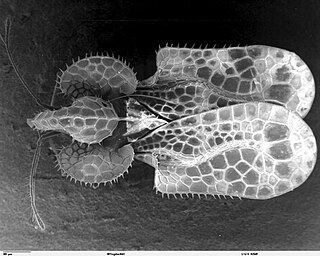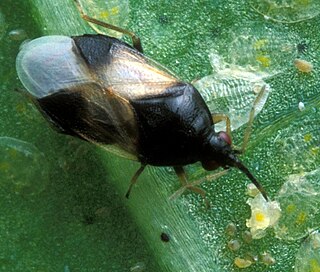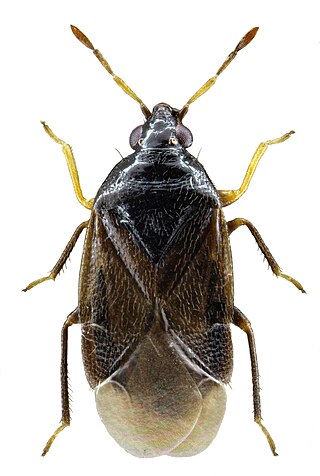
The Cimicomorpha are an infraorder of insects in the order Hemiptera, the true bugs. The rostrum and other morphology of all members apparently is adapted to feeding on animals as their prey or hosts. Members include bed bugs, bat bugs, assassin bugs, and pirate bugs.

The genus Orius consists of omnivorous bugs in the family Anthocoridae. Adults are 2–5 mm long and feed mostly on smaller insects, larva and eggs, such as spider mites, thrips, jumping plant lice, and white fly, but will also feed on pollen and vascular sap.

Orius insidiosus, common name the insidious flower bug, is a species of minute pirate bug, a predatory insect in the order Hemiptera. They are considered beneficial, as they feed on small pest arthropods and their eggs. They are mass-reared for use in the biological control of thrips.

Anthocoris is a genus of minute pirate bugs in the family Anthocoridae. There are at least 30 described species in Anthocoris.

Orius niger is a true bug. The species is found in the Palearctic from Europe east to Siberia and across Central Asia to China and India. It is widespread in Central Europe mostly in the south. In the Alps it is found up 1600 meters above sea level.

Anthocoris gallarumulmi is a true bug in the family Anthocoridae. The species is a West Palearctic species found on aphid-galled leaves of Ulmus minor and is a predator of the aphid Eriosoma ulmi It is also associated with aphid-leaf galls of Fraxinus excelsior, Ribes, Prunus spinosa and Crataegus monogyna.

Anthocorini is a tribe of minute pirate bugs in the family Anthocoridae. There are more than 30 described species in Anthocorini.

Halticini is a tribe of plant bugs in the family Miridae.

Eccritotarsini is a tribe of plant bugs in the family Miridae. There are about 14 genera and at least 40 described species in Eccritotarsini.

Scoloposcelis is a genus of minute pirate bugs in the family Lyctocoridae. There are about seven described species in Scoloposcelis.

Scolopini is a tribe of bugs in the family Lyctocoridae. There are at least 4 genera and about 10 described species in Scolopini.

Pseudophloeinae is a subfamily of leaf-footed bugs in the family Coreidae. There are at least 100 described species in Pseudophloeinae, distributed worldwide.

Dufouriellini is a tribe of minute pirate bugs in the family Lyctocoridae. There are about 7 genera and 15 described species in Dufouriellini.
Orius tristicolor, known generally as the minute flower bug or minute pirate bug, is a species of minute pirate bug in the family Anthocoridae. It is found in the Caribbean Sea, Central America, North America, Oceania, and South America.

Oriini is a tribe of minute pirate bugs in the family Anthocoridae. There are about 6 genera and more than 60 described species in Oriini.

Buchananiella is a genus of minute pirate bugs in the family Lyctocoridae. There are at least three described species in Buchananiella.

Dufouriellus is a monotypic genus of minute pirate bugs now placed in the tribe Anthocorini. The described species is Dufouriellus ater, which has been recorded from much of western Europe through to Bohemia, Moravia, Slovakia, southern Scandinavia and including the British Isles.

Lyctocoridae is a reconstituted family of bugs, formerly classified within the minute pirate bugs of the family Anthocoridae. It is widely distributed, with one species, being cosmopolitan.

Lasiochilinae is a subfamily of bugs, in the family Anthocoridae; some authorities place this at family level: "Lasiochilidae". It is most diverse in tropical areas, especially in the New World.

The Cardiastethini are a tribe of flower bugs, erected by Carayon in 1972 and based on the type genus Cardiastethus.


















